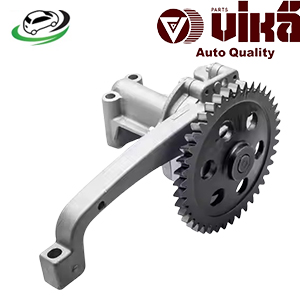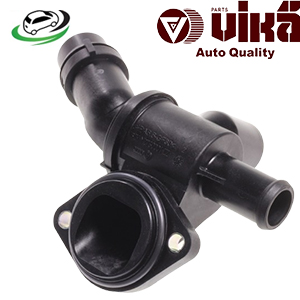-6%
Get AUDI A3 (8P1)/ A3 Sportback / VW EOS (1F7 1F8)/ Golf V (1K1)/ Jetta III (1K2)/ Passat B6 (3C2)/ Touran (1T1 1T2) Thermostat Assembly 06F121111G
The thermostat assembly is a critical component of an automotive cooling system, playing a vital role in regulating the engine’s operating temperature. By ensuring that the engine operates within a specific temperature range, the thermostat assembly helps optimize performance, fuel efficiency, and emissions. This detailed guide will explore the function of the thermostat assembly, its components, benefits, common issues, and maintenance tips to ensure optimal performance and longevity.
What is a Thermostat Assembly?
The thermostat assembly is a mechanical device located in the engine’s cooling system, typically situated between the engine and the radiator. It consists of a thermostat valve, housing, and often a temperature sensor. The primary purpose of the thermostat assembly is to regulate the flow of coolant between the engine and the radiator based on the engine’s temperature.
When the engine is cold, the thermostat remains closed, preventing coolant from circulating through the radiator. As the engine warms up, the thermostat opens at a predetermined temperature, allowing coolant to flow into the radiator for cooling. This cycling of coolant helps maintain the engine at its optimal operating temperature, which is crucial for efficient performance.
How Does a Thermostat Assembly Work?
The thermostat assembly operates based on temperature changes within the engine. Here’s a step-by-step breakdown of its function:
- Cold Engine Start:
When the engine is started, it begins to generate heat as fuel is burned. Initially, the engine’s temperature is low, and the thermostat remains closed. This prevents coolant from flowing into the radiator, allowing the engine to reach operating temperature more quickly. - Warming Up:
As the engine continues to run, its temperature rises. The thermostat is designed to open at a specific temperature, usually between 180°F and 220°F (82°C to 104°C), depending on the engine design and operating conditions. - Thermostat Opening:
Once the engine reaches the predetermined temperature, the thermostat valve opens, allowing coolant to flow from the engine to the radiator. This flow helps dissipate excess heat, preventing the engine from overheating. - Maintaining Temperature:
The thermostat continuously monitors the engine temperature. If the engine temperature drops below the set point, the thermostat will close, stopping coolant flow to the radiator. This cycling ensures that the engine operates within the optimal temperature range. - Cooling System Control:
The thermostat assembly is crucial in maintaining the overall efficiency of the cooling system. By regulating coolant flow, it ensures that the engine does not overheat or run too cool, both of which can negatively impact performance and fuel efficiency.
Components of a Thermostat Assembly
- Thermostat Valve:
The valve is the core component of the thermostat assembly. It opens and closes based on the temperature of the coolant. The valve is usually made of a metal housing that contains a temperature-sensitive element, such as a wax pellet or bi-metallic strip, that expands and contracts with temperature changes. - Thermostat Housing:
The housing encases the thermostat valve and provides a connection point for the coolant lines. It is typically made of aluminum or plastic and is designed to withstand high temperatures and pressures. - Temperature Sensor:
Some thermostat assemblies include a temperature sensor that monitors coolant temperature and provides data to the engine control unit (ECU). This information can help optimize fuel injection and ignition timing for better performance and efficiency. - Gasket:
A gasket is used to create a seal between the thermostat housing and the engine. This prevents coolant leaks and ensures that the cooling system maintains pressure.
Benefits of a Well-Functioning Thermostat Assembly
- Optimal Engine Temperature Regulation:
A properly functioning thermostat assembly ensures that the engine operates within its designed temperature range. This regulation is essential for efficient combustion, reducing emissions, and optimizing engine performance. - Improved Fuel Efficiency:
Maintaining the correct engine temperature enhances fuel combustion efficiency, resulting in better fuel economy. An engine that runs too cold may consume more fuel, while an overheated engine can lead to pre-ignition and knocking, reducing efficiency. - Reduced Emissions:
Proper temperature regulation helps minimize harmful emissions by ensuring complete combustion of fuel. This is increasingly important as vehicle emissions standards become stricter. - Prevention of Engine Overheating:
The thermostat assembly prevents the engine from overheating by regulating coolant flow. Overheating can lead to severe engine damage, including warped cylinder heads, blown head gaskets, and even complete engine failure. - Enhanced Heating System Performance:
A functioning thermostat assembly is crucial for the performance of the vehicle’s heating system. A properly heated engine allows for efficient cabin heating, providing comfort during cold weather.
Common Symptoms of a Failing Thermostat Assembly
- Overheating Engine:
If the thermostat fails to open, the engine may overheat, leading to potential damage. Signs of overheating include a rising temperature gauge, steam from the engine compartment, or a warning light on the dashboard. - Coolant Leaks:
A damaged thermostat housing or gasket can cause coolant leaks. This may manifest as puddles of coolant under the vehicle or visible leaks around the thermostat area. - Poor Cabin Heating:
If the thermostat remains closed, coolant may not circulate to the heater core, leading to inadequate cabin heating. Drivers may notice that the heater blows cold air, especially during cold weather. - Erratic Temperature Gauge Readings:
A malfunctioning thermostat can cause fluctuations in the engine temperature gauge. The gauge may rise and fall unexpectedly, indicating that the thermostat is not functioning correctly. - Check Engine Light:
If the engine control unit detects a problem with the cooling system, it may trigger the Check Engine Light. Diagnostic trouble codes (DTCs) related to the thermostat or cooling system may be stored in the ECU.
Maintenance Tips for Thermostat Assembly
- Regular Inspections:
Periodically inspect the thermostat assembly for signs of wear, damage, or leaks. Look for coolant pooling under the vehicle or signs of corrosion around the housing. - Monitor Engine Temperature:
Keep an eye on the engine temperature gauge while driving. If you notice fluctuations or the engine running hotter than usual, have the cooling system checked, including the thermostat assembly. - Replace at Recommended Intervals:
Most manufacturers recommend replacing the thermostat assembly every 60,000 to 100,000 miles. However, it’s essential to refer to the owner’s manual for specific recommendations. - Check Coolant Condition:
Ensure that the coolant is in good condition and properly mixed. Contaminated or degraded coolant can affect the thermostat’s performance and lead to overheating. - Use Quality Replacement Parts:
When replacing the thermostat assembly, choose high-quality OEM (original equipment manufacturer) or reputable aftermarket parts. Using inferior parts can result in premature failure and additional maintenance issues. - Flushing the Cooling System:
Regularly flush the cooling system according to the manufacturer’s recommendations. This practice helps remove contaminants and ensures the coolant remains effective in regulating engine temperature.
Conclusion
The thermostat assembly is an essential component of the automotive cooling system, playing a vital role in regulating engine temperature and ensuring optimal performance. By maintaining a proper operating temperature, the thermostat assembly contributes to improved fuel efficiency, reduced emissions, and prevention of engine overheating. Regular inspections, timely replacements, and proper maintenance of the thermostat assembly can help vehicle owners avoid costly repairs and ensure the longevity of their engine. Understanding the function and importance of this critical component allows for informed decisions about maintenance and care, ultimately leading to a more reliable and efficient vehicle.
Follow us on Facebook for more parts.




Reviews
Clear filtersThere are no reviews yet.